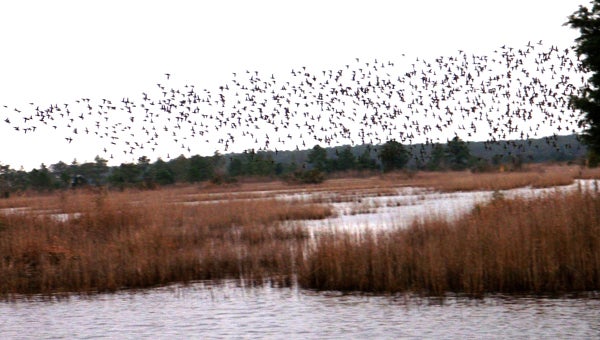Bait could be expensive, try shooting waterfowl instead
Published 12:46 pm Monday, January 5, 2015

FRED BONNER | CONTRIBUTED
SWAMPED: This cloud of blue and green wing teal is a great sight for waterfowl hunters but any time you see ducks concentrated this thick it may be a good time to check the area for the presence of bait.
Many newcomers to eastern North Carolina may wonder just why our coastal area is often referred to as being “The Gold Coast Of North Carolina.” It’s called this because when, years ago, federal game wardens flew over the area to patrol for waterfowl population numbers and violations, there was so much shelled corn shining up through the water in front of duck blinds that the area looked like “gold”.
During the market hunting years of waterfowl hunting, it was standard operating procedure for hunters to attract waterfowl to their hunting areas by placing food in the water. Shelled corn readily sinks to the bottom of the water and diving ducks such as canvasbacks or bluebills quickly become addicted to this easy food source. Hunters could easily shoot at the ducks that would fly off for a short time then, as the ducks became hungry, they’d fly back into the baited area and the waiting guns of the hunters. For ducks, it’s like a dope addict going back to a dealer looking for a fix. It was an easy way for hunters to kill a lot of waterfowl and when bag limits were unheard of (or ignored), it decimated waterfowl populations.
Federal and state wildlife laws were quickly passed and enforced that helped to conserve the dwindling numbers of ducks and geese. The new conservation rules slowed down the practice of baiting waterfowl, but it did not stop entirely. It still continues wherever you find waterfowl hunting and bird watchers who like to simply observe the birds as they feed.
Waterfront property owners who liked to feed ducks in front of their homes to observe or photograph the birds found that this practice irritated duck hunters who (under North Carolina wildlife laws) had to be 300 yards away from a baited area or (under federal baiting laws) could have been charged if bait was as much as 50-miles away from a baiting source. If that sounds confusing, it is (or rather, was).
It is not against the law to put out food for waterfowl (unless it’s totally outlawed as with certain municipalities). However, it is against the law to shoot or attempt to kill, waterfowl over or with the aid of bait. Waterfowl hunters who might have been charged with a baiting violation, even though they had no idea that they were hunting over bait, soon found out that they were in really big trouble because, under the federal waterfowl baiting laws, they were guilty until proven innocent (strict liability).
Anti-hunting organizations such as PETA or the Defenders of Wildlife soon learned that they could literally stop waterfowl hunters from enjoying their sport by throwing a bucket of shelled corn in front of numerous hunting blinds found along our coastline, then calling the wardens to report that the area was baited. They were simply “feeding the ducks” and helping them over the winter.
Duck hunters who made honest attempts to stay away from a baited area found that they were in deep trouble because bait may have been there within the nine-day period before the hunt. Or, under the federal law, the bait could have been miles away from the hunter’s blinds, but the birds were attracted to the bait and passing within gun range of the hunters on their way to the bait. Both federal and state baiting laws were confusing and many hunters felt that they were just plain wrong.
Several years ago, waterfowl hunters went to the Governor’s office here in North Carolina and succeeded in having the state regulations modified, so that they were fair to the entire hunting community. They also testified in Congressional Oversight Hearings about the unfair federal waterfowl baiting regulations and succeeded in having these laws changed to where they were less confusing and set up to protect innocent hunters who blundered into a baited area to hunt.
Nowadays, under both federal and state baiting regulations and laws, the game wardens are required to show that the hunters either knew or should have known that bait was present while they hunted there. In other words, the old, strict liability rule was thrown out and now hunters charged with a baiting violation were innocent until proven guilty. Waterfowl hunters still needed to make a reasonable effort to determine the presence of bait before they hunt there though.
Many waterfowl hunters are now asking if a better idea concerning the baiting of waterfowl may be to simply make it legal to bait waterfowl in every state, carefully enforce the bag limits and adjust these limits (if necessary) to maintain good waterfowl population levels. Many of the naturally occurring sources of food for these birds is in short supply because of pollution or natural disasters and the ducks and geese would benefit by having a good healthy food source consisting of corn or other cultivated grains.
It’s well-known that waterfowl hunters with enough cash on hand to have impoundments that allow them to be drained, planted with grain crops that aren’t harvested or scattered and then flooded again for the explicit purpose of legally hunting there enjoy what lesser endowed hunters refer to as “legalized baiting areas.” By simply making it legal for all waterfowl hunters to use bait, the playing field would be leveled for all waterfowl hunters.
Several years ago, a well-known federal game warden stated, “If waterfowl hunters don’t feel that a regulation is fair, they’re not going to go by it. If, on the other hand, they feel that the regulation is fair to all concerned and actually does protect the resource, they’ll accept it and go by it.” This concept also applies to the Gold Coast of North Carolina. The practice of illegally shooting waterfowl will always go on in this section of the Atlantic Flyway to some extent, as long as some of the hunters don’t agree with the regulation’s fairness.
Maybe it’s time for both federal and state wildlife managers to take another look at the waterfowl baiting laws.





